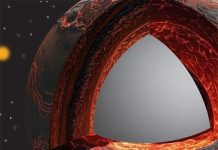
Astronomers have captured a haunting image of a vast nebula, dubbed the “cosmic bat,” 10,000 light-years away. This massive stellar nursery, captured by ESO’s VST, glows as newborn stars ignite gas and dust
Astronomers at the European Southern Observatory (ESO) have captured a haunting image of a vast nebula, dubbed the “cosmic bat,” spreading its crimson wings across the southern sky. Timed perfectly for the season, this ghostly cloud of gas and dust provides a spectacular view of a massive stellar nursery, where new stars are igniting and painting the cosmos red.
Located approximately 10,000 light-years from Earth, the eerie formation was spotted soaring between the constellations Circinus and Norma. Its expansive shape, resembling a bat in flight, spans an area about four times the size of a full moon. The dramatic image was primarily captured in visible light by the VLT Survey Telescope (VST), located at ESO’s Paranal Observatory in Chile’s Atacama Desert.
Space exploration: Celestial nursery glows crimson
The nebula’s intense red glow is the hallmark of a stellar nursery. Within the massive cloud of gas and dust, newborn stars are releasing powerful radiation. This energy excites nearby hydrogen atoms, causing them to ionise and emit the brilliant crimson light seen across the structure. The “cosmic bat” is, in essence, a giant cosmic cauldron of star formation.
Adding to the spooky silhouette are dark, threadlike filaments that form the bat’s “skeleton.” These are dense, cooler clumps of gas containing tiny dust particles that effectively block the background starlight, creating striking, shadowy features that define the celestial phantom’s outline.
The structure is a composite of several known cosmic clouds, though the informal “cosmic bat” name applies to the overall shape. The brightest catalogued regions include RCW 94, which forms the bat’s right wing, and RCW 95, which makes up its body. The rest of the formation remains unnamed, adding a touch of cosmic mystery to the already captivating sight.
The final, vivid portrait was achieved by combining visible light observations from the VST with crucial infrared data from ESO’s Visible and Infrared Survey Telescope for Astronomy (VISTA).
The infrared observations allowed astronomers to peer through the thickest, dustiest regions of the nebula, revealing hidden details of the complex and beautiful process of star birth within this haunting corner of the cosmos.










